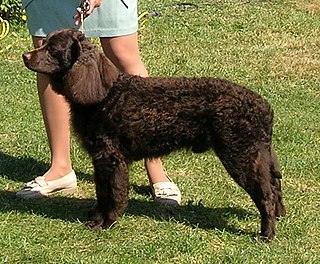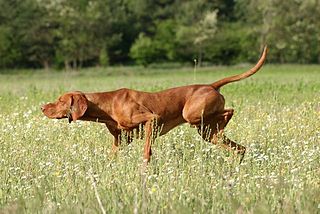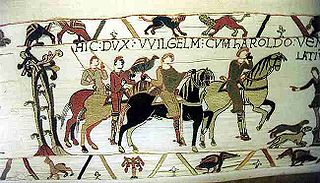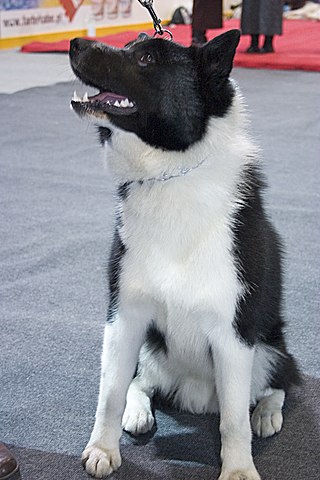
A sled dog is a dog trained and used to pull a land vehicle in harness, most commonly a sled over snow.

The American Water Spaniel is a breed of spaniel which originated in the United States. It was developed in the state of Wisconsin during the 19th century from a number of other breeds, including the Irish and English Water Spaniels. The breed was saved by Dr. Fred J. Pfeifer, who set up the breed club and standard, and whose work led to recognition for the breed by the United Kennel Club, and later, the American Kennel Club. While they are the state dog of Wisconsin, they remain a rare breed.

A retriever is a type of gun dog that retrieves game for a hunter. Generally gun dogs are divided into three major classifications: retrievers, flushing spaniels, and pointing breeds. Retrievers were bred primarily to retrieve birds or other prey and return them to the hunter without damage; retrievers are distinguished in that nonslip retrieval is their primary function. As a result, retriever breeds are bred for soft mouths and a great willingness to please, learn, and obey. A soft mouth refers to the willingness of the dog to carry game in its mouth without biting into it. "Hard mouth" is a serious fault in a hunting dog and is very difficult to correct. A hard-mouthed dog renders game unpresentable or at worst inedible.

A working dog is a dog used to perform practical tasks, as opposed to pet or companion dogs.

Husky is a general term for a dog used in the polar regions, primarily and specifically for work as sled dogs. It refers to a traditional northern type, notable for its cold-weather tolerance and overall hardiness. Modern racing huskies that maintain arctic breed traits represent an ever-changing crossbreed of the fastest dogs.

Gun dogs or bird dogs are types of hunting dogs developed to assist hunters in finding and retrieving game, typically various fowls that are shot down on the flight. The term hunting dog is broad and includes all breeds and skills of hunting canines, but "gun dogs" refers to canines that are trained to work alongside a loud firearm while hunting or retrieving game. Gun dogs are divided into three main categories: pointers and retrievers, setters and spaniels, and water dogs.

Pointing dogs, sometimes called bird dogs, are a type of gundog typically used in finding game. Gundogs are traditionally divided into three classes: retrievers, flushing dogs, and pointing breeds. The name pointer comes from the dog's instinct to point, by stopping and aiming its muzzle towards game. This demonstrates to the hunter the location of their quarry and allows them to move into gun range. Pointers were selectively bred from dogs who had abundant pointing and backing instinct. They typically start to acquire their hunting instincts at about 2 months of age.

The English Cocker Spaniel is a breed of gun dog. It is noteworthy for producing one of the most varied numbers of pups in a litter among all dog breeds. The English Cocker Spaniel is an active, good-natured, sporting dog standing well up at the withers and compactly built. There are "field" or "working" cockers and "house" cockers. It is one of several varieties of spaniel and is the foundation of its American cousin, the American Cocker Spaniel. The English Cocker is closer to the working-dog form of the Field Spaniel and the English Springer Spaniel. English Cocker Spaniels are also known as the "Merry Spaniel" due to their constantly wagging tail.

A spitz is a type of domestic dog consisting of between 50 and 70 breeds depending on classification. There is no precise definition of 'spitz' but typically most spitz breeds have pricked ears, almond shaped eyes, a pointed muzzle, a double coat, and a tail that curves over the back.

The Pointer, sometimes called the English Pointer, is a medium-sized breed of pointing dog developed in England. Pointers are used to find game for hunters, and are considered by gundog enthusiasts to be one of the finest breeds of its type; however, unlike most other hunting breeds, its purpose is to point, not retrieve game.

The Karelian Bear Dog is a Finnish breed of dog. In its home country, it is seen by many as a national treasure. Karelian Bear Dogs will hunt a variety of animals. Its quick reflexes and fearless nature have made it very popular for hunting large game including brown bears, moose, and wild boar. It was the breed's ability to hunt bears that earned the breed its name. The Karelian Bear Dog is among the top 10 most common dog breeds in Finland.

Royal hunting, also royal art of hunting, was a hunting practice of the aristocracy throughout the known world in the Middle Ages, from Europe to Far East. While humans hunted wild animals since time immemorial, and all classes engaged in hunting as an important source of food and at times the principal source of nutrition, the necessity of hunting was transformed into a stylized pastime of the aristocracy. More than a pastime,l interaction, essential training for war, and a privilege and measurement of nobility. In Europe in the High Middle Ages the practice was widespread.

The Portuguese Podengo, also known as the Podengo Português or Portuguese Warren Hound, is a hound breed from Portugal. As a breed, the Podengo is divided into three size categories that are not interbred: small (Pequeno), medium (Médio) and large (Grande). Their coats are either short and 'smooth', or longer and 'wired'. The smooth coated variety is traditional, whereas the wire coated variety is an outcome of the assimilation of various other breeds during the 20th century. In general, the breed is healthy; the Pequeno (small) variety has an average lifespan of approximately 15–17 years.

The West Siberian Laika or WSL, is a breed of spitz–type hunting dog. Russian publications indicate that the term West Siberian Laika loosely applied to hunting dogs originating with the Mansi and Khanty people in Ural and West Siberia, but there were no standards or registrations of WSL as such until 1930. Then WWII disrupted it for a while, but systematic breeding with registrations resumed after the war ended, in 1946. This was the time the breed began taking modern shape. Before that hunters only knew of Mansi Laika and Khanty Laika. In early 1960 many hunters in Ural still preferred the term Mansi Laika, when speaking of West Siberian Laika. In Russian language, the term Laika originated from the word layat that means to bark. The word Laika simply means barker. Any hunting Laika is a bark pointer. It is a versatile dog depending on use and environment, but in certain parts of the country they have become more specialized.

Laikas are aboriginal spitz from Northern Russia, especially Siberia but also sometimes expanded to include Nordic hunting breeds. Laika breeds are primitive dogs who flourish with minimal care even in hostile weather. Generally, laika breeds are expected to be versatile hunting dogs, capable of hunting game of a variety of sizes by treeing small game, pointing and baying larger game and working as teams to corner bear and boar. However a few laikas have specialized as herding or sled dogs.

Dog types are broad categories of domestic dogs based on form, function, or style of work, lineage, or appearance. Some may be locally adapted dog types that may have the visual characteristics of a modern purebred dog. In contrast, modern dog breeds strictly adhere to long-established breed standards,[note 1] that began with documented foundation breeding stock sharing a common set of inheritable characteristics, developed by long-established, reputable kennel clubs that recognize the dog as a purebred.

Russo-European Laika is the name of a breed of hunting dog that originated in the forested region of northern Europe and Russia, one of several breeds developed from landrace Laika dogs of Spitz type. The Russo-European Laika itself dates to a breeding program begun in 1944 by E. I. Shereshevsky of the All-Union Research Institute for the Hunting Industry, in Kalinin Province.

Wolf hunting with dogs is a method of wolf hunting which relies on the use of hunting dogs. While any dog, especially a hound used for hunting wolves may be loosely termed a "wolfhound", several dog breeds have been specifically bred for the purpose, some of which, such as the Irish Wolfhound, have the word in their breed name.

The Karelo-Finnish Laika is a breed of spitz-type dog from the Karelia area of Russia.

The Yakutian Laika is an ancient working dog breed that originated in the Arctic seashore of the Sakha (Yakutia) Republic. Yakutian Laikas are multipurpose laikas, with many lineages able to herd reindeer, hunt game and/or pull a sled. They are registered with the Russian Kennel Club, the FCI and the AKC's Foundation Stock Service in 2017.








































